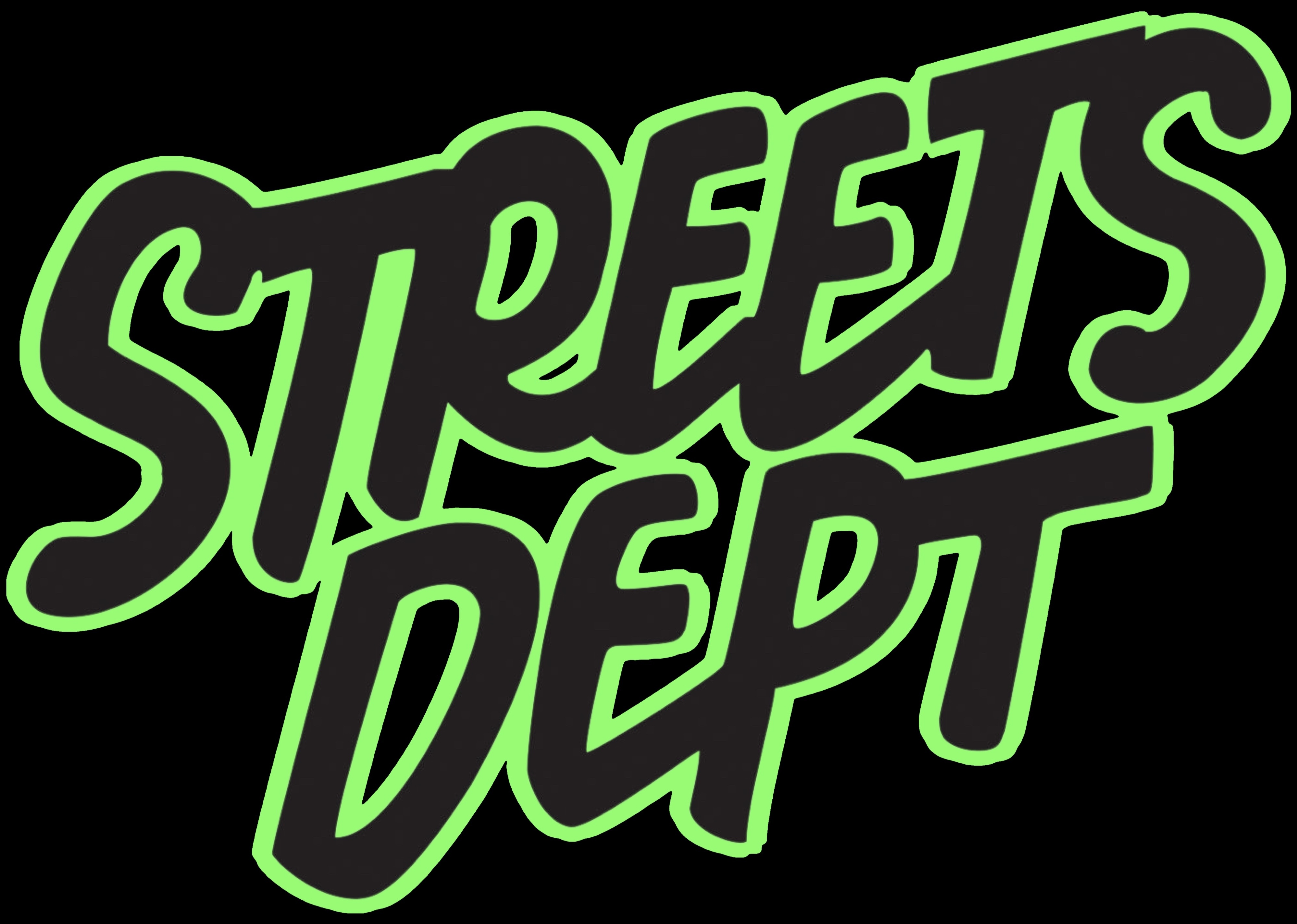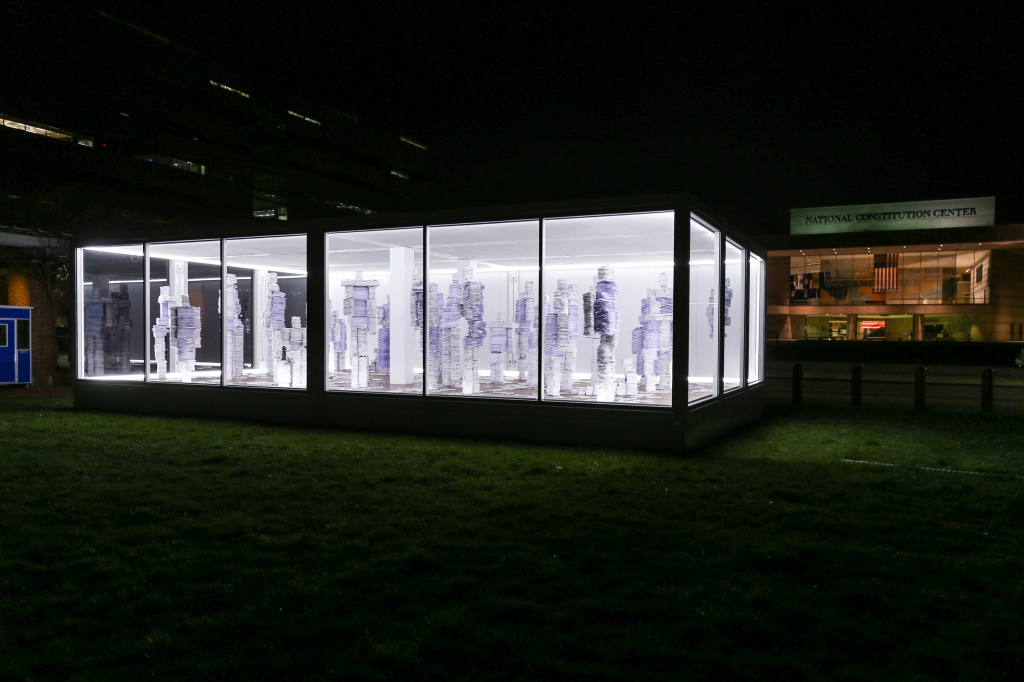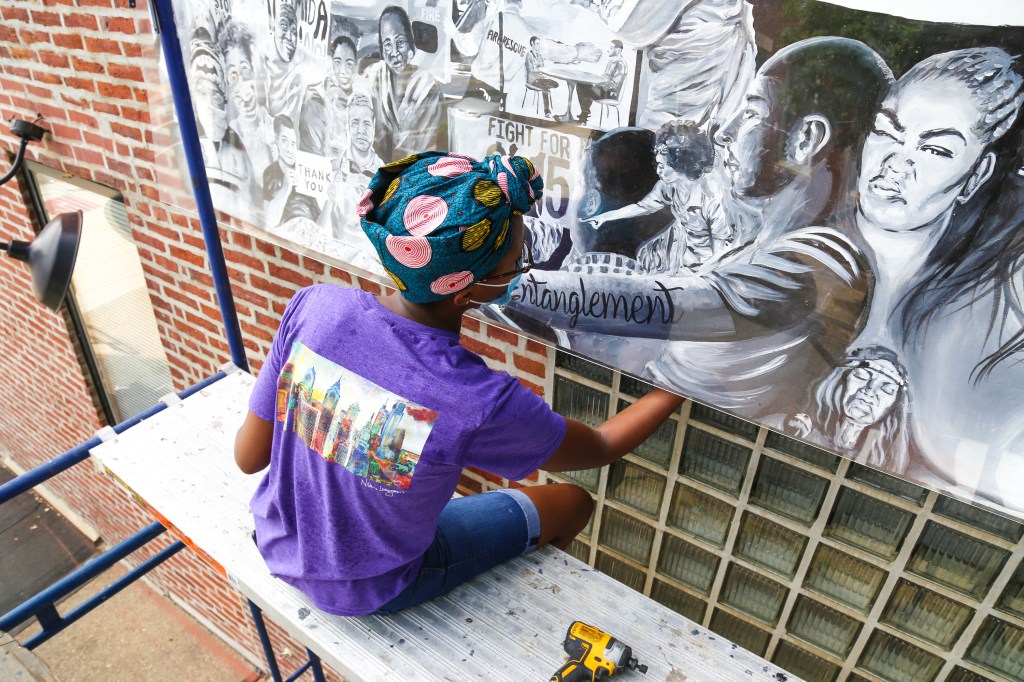
First two quick programming notes:
1) This interview was originally published in December, 2021, in Issue #1 of Streets Dept Magazine. For archival purposes, we’re now republishing it here on the blog.
2) We are thrilled to be in the middle of creating Issue #2 of Streets Dept Magazine, which you can wait to purchase in January 2023 or pre-order now by becoming a Streets Dept Patreon member at the Paper Tier or above. Not only do our Patreon members help us to create these annual magazines with their support, but they are rewarded for that support by getting their magazines mailed to them first! If you become a Streets Dept Patreon member (at the Paper Tier or above) by Monday, November 28 and plan to remain a member for a least three months, we’ll mail your magazine out this December! Click here to become a Streets Dept Patreon member now!

Interview and photos by Streets Dept Contributor Eric Dale
Adam Crawford is a muralist and fine artist who lives in South Philadelphia. Since painting his first mural at Awesome Dudes Printing in early 2016, Adam has quickly gone on to paint dozens of murals in Philly, Chicago, Pittsburgh, D.C., and New York. But it’s almost as if he needed an incubation period before this recent flourishing: despite his Pennsylvania Academy of Fine Arts degree, Adam had been, as he puts it, “dead to the world” for a number of years. Following a rough patch in his life, he had stopped renting a studio space and almost completely checked out from the art scene. “I got so off track it was ridiculous,” he says.
That time in his life happened to coincide with the explosion of the internet and computer technology in general, but Adam was completely offline. So it’s surprising that his art practice is so rooted in technology now—he rarely sketches, instead creating all of his designs in Adobe Illustrator. And instead of moving back into a studio, he paints in his basement. He learned early on that doing things the “normal” way created a stifling sense of pressure for him, and as you’ll see in our interview, he traces that rejection of normalcy all the way back to his childhood.

Eric: Your work is simultaneously abstract and organized, often with a lot of precise geometry. What’s your approach to balancing these seemingly conflicting qualities?
Adam: I treat those two visual concepts, organic shapes and more rigid geometry, as two contrasting ideas. I like to balance them sort of like a visual rhythm. Because I fill my compositions almost completely, I use those two things as a way to create something that you see quickly; and then there’s rest for your eyes. It helps me to create this flow through a mural or a painting.

Eric: What are some of your artistic influences or inspirations?
Adam: A local guy, Jim Houser, is somebody I always looked up to—the way he organizes a painting; the way it tells a story. I always thought his stuff was really interesting; the graphic nature of it. And then the patterny stuff that Barry McGee did—where he was just smashing patterns together—I thought that looked so cool. I also look at Shepard Fairy or Tristan Eaton a lot, because there’s these ways that they put multiple ideas together that allows them to use two different faces or two different ideas or two different patterns. It’s helped me to see a way that you can make very complex images and have them broken down into simplified compartments. You’re almost just dealing with one little section at a time; they’re each their own idea, but you figure out a way to make them work together, like a specific color that they might all share.

Eric: You’re a skater, and you also paint a lot of skate decks. How has skate culture influenced your work?
Adam: Massively. I think if you ask anyone who skates and does art or something creative, they’ll say that it’s got everything to do with growing up in that subculture. It’s not so sub now, but when I was a kid, skating wasn’t this thing that everyone accepted or knew about—or recognized as being its own culture with its own graphics and its own type of imagery and its own grit. I think because skateboarding had that visual aspect to it, it’s probably what drew me to it in the first place. Skating is like… first you see all the cool graphics, and then you find out how fun it is, and then you find out there’s this secret punk aspect to it, and it just gets better and better. It just takes over. I did other things as a kid, sports and stuff, but nothing could take its place. I was always trying to skate more and always trying to get away from that normalcy.
I think that was another part of it. I grew up in a suburb that was just dipped in that… normalcy. And I came from a family of divorce, but no one else in the town was divorced, so I feel like maybe there was a part of me that was like I don’t really fit that normal thing. I feel more comfortable being a part of something that’s less about normalcy. I’m not going to go to the soccer game with my dad; he’s not around, so it’s not going to feel good. I think that all created a desire to do something different, and I think that’s what a lot of people who are creative go through in some way or another. There’s a drive to break out of that box that people can find themselves in—or that a lot of people almost like to be in. To be creative is to try and find your own thing.

Eric: Your Instagram bio currently says you’re open to projects “anywhere in the world.” I know you’ve painted murals in other cities, but have you done any projects outside the U.S. yet? Is that what you’re aiming for?
Adam: That would be really awesome. Anyone who does murals is trying to reach people. But I haven’t had a project outside of the U.S. I’m sort of surprised that I’ve been able to go to other places outside Philadelphia! It feels like I’ve only been doing the mural thing for about three years. I just got hired in the beginning by a company that was growing, and I busted my ass for them on that first one. So I think I got really lucky with that, because it allowed me to do so many murals in a short amount of time. Every time you do one, you learn something, and it’s gotten me to a place where I feel pretty confident with what I do. That specific client helped me progress faster than normal.

Eric: What do you find easiest and hardest about painting murals?
Adam: I think the hardest thing is getting the idea onto the wall. I spend a lot of time designing things almost per inch, to have certain colors just graze another color. So it’s really important to me that things are dead-on. I think it’s those tiny, tiny details—like wrapping the design over a gutter—that really makes things look so much better; when it’s almost like some form has been dipped in your mural. When you’re doing your drawing and you’re scaling to the wall and you miss those details—your mural slowly suffers, the less accurately you can get your design up there. That’s the part that always makes me nervous. Cause there’s a few ways to do it, and I tend to do the hardest, most time-consuming ways. But in the end, you get these good transfers or a good perfect scale of what you want. Then all you have to do is figure out how to execute it with your colors.

Eric: What do you want to be known for?
Adam: That’s a really hard question. Maybe as someone that sort of… contributes. Just someone that contributes to the culture, or to the city as a whole, making it a nicer or more appealing environment through the murals. With any kind of design, you’re trying to shape culture or what people see as art, so that kind of stuff would be really cool to be known for—that you’ve contributed to the whole idea of that time period; of what was cool. That’s a huge thing to do, and I think a lot of people don’t get that opportunity—you have to be pretty well-known for that. But that would be like a fantasy.
This interview has been edited for length and clarity.





Leave a comment